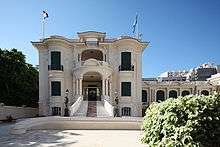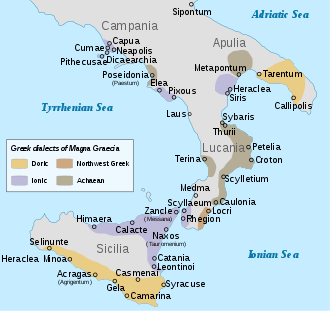Alexandria
Alexandria (/ˌælɪɡˈzændriə/ or /-ˈzɑːnd-/;[5] Arabic: الإسكندرية al-ʾIskandariyya;[6][7] Egyptian Arabic: اسكندرية Eskendereyya; Coptic: ⲣⲁⲕⲟϯ Rakodī;[8] Greek: Αλεξάνδρεια Alexandria)[8][9] is the second-largest city in Egypt and a major economic center. With a population of 5,200,000, Alexandria is the largest city on the Mediterranean, the sixth-largest city in the Arab world and the ninth-largest in Africa. The city extends about 40 km (25 mi) at the northern coast of Egypt along the Mediterranean Sea. Alexandria is a popular tourist destination, and also an important industrial center because of its natural gas and oil pipelines from Suez.
Alexandria الإسكندرية (Arabic)
Αλεξάνδρεια (Greek)
| |||||||||||||
|---|---|---|---|---|---|---|---|---|---|---|---|---|---|
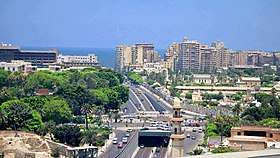 .jpg)     Clockwise from top: View of Shatby district and Suez Canal street, skyline of the eastern district (Sharq), Stanley Bridge, Montaza Palace, Bibliotheca Alexandrina and the statue of Ptolemy II Philadelphus, Planetarium Science Center (with corniche in the background). | |||||||||||||
 Emblem | |||||||||||||
| Nicknames: Mediterranean's Bride, Pearl of the Mediterranean, Aleks | |||||||||||||
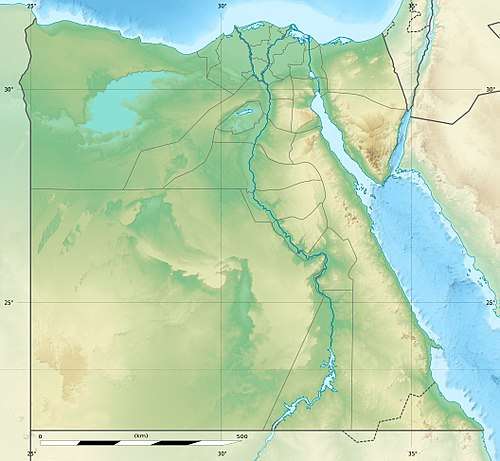 Alexandria Location in Egypt | |||||||||||||
| Coordinates: 31°12′N 29°55′E | |||||||||||||
| Country | |||||||||||||
| Governorate | Alexandria | ||||||||||||
| Founded | 331 BC | ||||||||||||
| Founded by | Alexander the Great | ||||||||||||
| Government | |||||||||||||
| • Governor | Elsherif[1] | ||||||||||||
| Area | |||||||||||||
| • Total | 2,679 km2 (1,034 sq mi) | ||||||||||||
| Elevation | 5 m (16 ft) | ||||||||||||
| Population (October 2018[2]) | |||||||||||||
| • Total | 5,200,000 | ||||||||||||
| • Density | 1,900/km2 (5,000/sq mi) | ||||||||||||
| Demonym(s) | Alexandrian, Alexandrine (Arabic: إسكندراني) | ||||||||||||
| Time zone | UTC+2 (EST) | ||||||||||||
| Postal code | 21500 | ||||||||||||
| Area code(s) | (+20) 3 | ||||||||||||
| Website | Alexandria.gov.eg | ||||||||||||
| r-ꜥ-qd(y)t (Alexandria)[3][4] in hieroglyphs |
|---|
Alexandria was founded in c. 331 BC by Alexander the Great,[10] king of Macedon and leader of the Greek League of Corinth, during his conquest of the Achaemenid Empire. An Egyptian village named Rhacotis existed at the location and grew into the Egyptian quarter of Alexandria. Alexandria grew rapidly to become an important center of Hellenistic civilization and remained the capital of Ptolemaic Egypt and Roman and Byzantine Egypt for almost 1,000 years, until the Muslim conquest of Egypt in AD 641, when a new capital was founded at Fustat (later absorbed into Cairo). Hellenistic Alexandria was best known for the Lighthouse of Alexandria (Pharos), one of the Seven Wonders of the Ancient World; its Great Library (the largest in the ancient world); and the Necropolis, one of the Seven Wonders of the Middle Ages. Alexandria was the intellectual and cultural center of the ancient Mediterranean world for much of the Hellenistic age and late antiquity.[10] It was at one time the largest city in the ancient world before being eventually overtaken by Rome.
The city was a major center of early Christianity and was the center of the Patriarchate of Alexandria, which was one of the major centers of Christianity in the Eastern Roman Empire. In the modern world, the Coptic Orthodox Church and the Greek Orthodox Church of Alexandria both lay claim to this ancient heritage.
Following the Arab conquest of Egypt in AD 641, the city was plundered and lost its significance before re-emerging in the modern era.[11] From the late 18th century, Alexandria became a major center of the international shipping industry and one of the most important trading centers in the world, both because it profited from the easy overland connection between the Mediterranean Sea and the Red Sea, and the lucrative trade in Egyptian cotton.
History
Ancient era
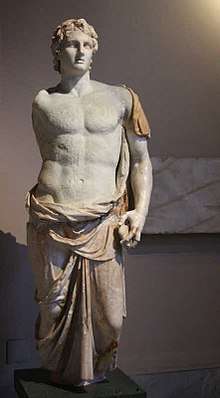
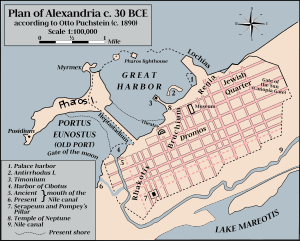
Recent radiocarbon dating of seashell fragments and lead contamination show human activity at the location during the period of the Old Kingdom (27th-21st centuries BC) and again in the period 1000-800 BC, followed by the absence of activity thereafter.[12] From ancient sources it is known there existed a trading post at this location during the time of Rameses the Great for trade with Crete, but it had long been lost by the time of Alexander's arrival.[10] A small Egyptian fishing village named Rhakotis (Egyptian:*Raˁ-Ḳāṭit, written rˁ-ḳṭy.t, 'That which is built up') existed since the 13th century BC in the vicinity and eventually grew into the Egyptian quarter of the city.[10] Just east of Alexandria (where Abu Qir Bay is now), there was in ancient times marshland and several islands. As early as the 7th century BC, there existed important port cities of Canopus and Heracleion. The latter was recently rediscovered under water.
Alexandria was founded by Alexander the Great in April 331 BC as Ἀλεξάνδρεια (Alexandreia). Passing through Egypt, Alexander wanted to build a large Greek city on Egypt's coast that would bear his name. He chose the site of Alexandria, envisioning the building of a causeway to the nearby island of Pharos that would generate two great natural harbors.[10] Alexandria was intended to supersede Naucratis as a Hellenistic center in Egypt, and to be the link between Greece and the rich Nile valley. A few months after the foundation, Alexander left Egypt and never returned to the city during his life.
After Alexander's departure, his viceroy Cleomenes continued the expansion. The architect Dinocrates of Rhodes designed the city, using a Hippodamian grid plan. Following Alexander's death in 323 BC, his general Ptolemy Lagides took possession of Egypt and brought Alexander's body to Egypt with him.[13] Ptolemy at first ruled from the old Egyptian capital of Memphis. In 322/321 BC he had Cleomenes executed. Finally, in 305 BC, Ptolemy declared himself Pharaoh as Ptolemy I Soter ("Savior") and moved his capital to Alexandria.
Although Cleomenes was mainly in charge of overseeing Alexandria's early development, the Heptastadion and the mainland quarters seem to have been primarily Ptolemaic work. Inheriting the trade of ruined Tyre and becoming the center of the new commerce between Europe and the Arabian and Indian East, the city grew in less than a generation to be larger than Carthage. In a century, Alexandria had become the largest city in the world and, for some centuries more, was second only to Rome. It became Egypt's main Greek city, with Greek people from diverse backgrounds.[14]
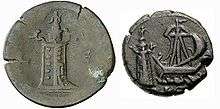
Alexandria was not only a center of Hellenism, but was also home to the largest urban Jewish community in the world. The Septuagint, a Greek version of the Tanakh, was produced there. The early Ptolemies kept it in order and fostered the development of its museum into the leading Hellenistic center of learning (Library of Alexandria), but were careful to maintain the distinction of its population's three largest ethnicities: Greek, Jewish, and Egyptian.[15] By the time of Augustus, the city walls encompassed an area of 5.34 km2, and the total population in Roman times was around 500–600,000.[16]
According to Philo of Alexandria, in the year 38 of the Common era, disturbances erupted between Jews and Greek citizens of Alexandria during a visit paid by the Jewish king Agrippa I to Alexandria, principally over the respect paid by the Jewish nation to the Roman emperor, and which quickly escalated to open affronts and violence between the two ethnic groups and the desecration of Alexandrian synagogues. The violence was quelled after Caligula intervened and had the Roman governor, Flaccus, removed from the city.[17]
In AD 115, large parts of Alexandria were destroyed during the Kitos War, which gave Hadrian and his architect, Decriannus, an opportunity to rebuild it. In 215, the emperor Caracalla visited the city and, because of some insulting satires that the inhabitants had directed at him, abruptly commanded his troops to put to death all youths capable of bearing arms. On 21 July 365, Alexandria was devastated by a tsunami (365 Crete earthquake),[18] an event annually commemorated years later as a "day of horror".[19]
Islamic era
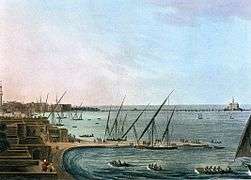
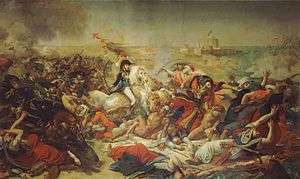
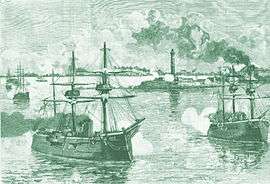
In 619, Alexandria fell to the Sassanid Persians. Although the Byzantine Emperor Heraclius recovered it in 629, in 641 the Arabs under the general 'Amr ibn al-'As invaded it during the Muslim conquest of Egypt, after a siege that lasted 14 months. The first Arab governor of Egypt recorded to have visited Alexandria was Utba ibn Abi Sufyan, who strengthened the Arab presence and built a governor's palace in the city in 664–665.[20][21]
After the Battle of Ridaniya in 1517, the city was conquered by the Ottoman Turks and remained under Ottoman rule until 1798. Alexandria lost much of its former importance to the Egyptian port city of Rosetta during the 9th to 18th centuries, and only regained its former prominence with the construction of the Mahmoudiyah Canal in 1807.
Alexandria figured prominently in the military operations of Napoleon's expedition to Egypt in 1798. French troops stormed the city on 2 July 1798, and it remained in their hands until the arrival of a British expedition in 1801. The British won a considerable victory over the French at the Battle of Alexandria on 21 March 1801, following which they besieged the city, which fell to them on 2 September 1801. Muhammad Ali, the Ottoman governor of Egypt, began rebuilding and redevelopment around 1810, and by 1850, Alexandria had returned to something akin to its former glory.[22] Egypt turned to Europe in their effort to modernize the country. Greeks, followed by other Europeans and others, began moving to the city. In the early 20th century, the city became a home for novelists and poets.[11]
In July 1882, the city came under bombardment from British naval forces and was occupied.[23]
In July 1954, the city was a target of an Israeli bombing campaign that later became known as the Lavon Affair. On 26 October 1954, Alexandria's Mansheya Square was the site of a failed assassination attempt on Gamal Abdel Nasser.[24]
Europeans began leaving Alexandria following the 1956 Suez Crisis that led to an outburst of Arab nationalism. The nationalization of property by Nasser, which reached its highest point in 1961, drove out nearly all the rest.[11]
Ibn Battuta in Alexandria
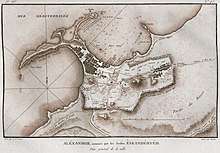
In reference to Alexandria, Egypt, Ibn Battuta speaks of great saints that resided here. One of them being Imam Borhan Oddin El Aaraj. He was said to have the power of working miracles. He told Ibn Battuta that he should go find his three brothers, Farid Oddin, who lived in India, Rokn Oddin Ibn Zakarya, who lived in Sindia, and Borhan Oddin, who lived in China. Battuta then made it his purpose to find these people and give them his compliments. Sheikh Yakut was another great man. He was the disciple of Sheikh Abu Abbas El Mursi, who was the disciple of Abu El Hasan El Shadali, who is known to be a servant of God. Abu Abbas was the author of the Hizb El Bahr and was famous for piety and miracles. Abu Abd Allah El Murshidi was a great interpreting saint that lived secluded in the Minyat of Ibn Murshed. He lived alone but was visited daily by emirs, viziers, and crowds that wished to eat with him. The Sultan of Egypt (El Malik El Nasir) visited him, as well. Ibn Battuta left Alexandria with the intent of visiting him.[25]
Ibn Battuta also visited the Pharos lighthouse on 2 occasions; in 1326 he found it to be partly in ruins and in 1349 it had deteriorated further, making entrance to the edifice impossible.[26]
Timeline
The most important battles and sieges of Alexandria include:
- Siege of Alexandria (47 BC), Julius Caesar's civil war
- Battle of Alexandria (30 BC), final war of the Roman Republic
- Siege of Alexandria (619), Byzantine-Persian Wars
- Siege of Alexandria (641), Rashidun conquest of Byzantine Egypt
- Alexandrian Crusade (1365), a crusade led by Peter de Lusignan of Cyprus which resulted in the defeat of the Mamluks and the sack of the city.
- Battle of Alexandria (1801), Napoleonic Wars
- Siege of Alexandria (1801), Napoleonic Wars
- Alexandria expedition (1807), Napoleonic Wars
Ancient layout
Greek Alexandria was divided into three regions:
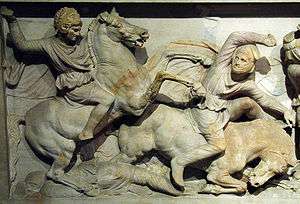
- Brucheum
- Brucheum is the Royal or Greek quarter and forms the most magnificent portion of the city. In Roman times Brucheum was enlarged by the addition of an official quarter, making four regions in all. The city was laid out as a grid of parallel streets, each of which had an attendant subterranean canal;
- The Jewish quarter
- This quarter is the northeast portion of the city;
- Rhakotis
- Rhakotis is the old city that was absorbed into Alexandria. It was occupied chiefly by Egyptians. (from Coptic Rakotə "Alexandria").
Two main streets, lined with colonnades and said to have been each about 60 meters (200 ft) wide, intersected in the center of the city, close to the point where the Sema (or Soma) of Alexander (his Mausoleum) rose. This point is very near the present mosque of Nebi Daniel; and the line of the great East–West "Canopic" street, only slightly diverged from that of the modern Boulevard de Rosette (now Sharia Fouad). Traces of its pavement and canal have been found near the Rosetta Gate, but remnants of streets and canals were exposed in 1899 by German excavators outside the east fortifications, which lie well within the area of the ancient city.
Alexandria consisted originally of little more than the island of Pharos, which was joined to the mainland by a 1,260-metre-long (4,130 ft) mole and called the Heptastadion ("seven stadia"—a stadium was a Greek unit of length measuring approximately 180 metres or 590 feet). The end of this abutted on the land at the head of the present Grand Square, where the "Moon Gate" rose. All that now lies between that point and the modern "Ras al-Tin" quarter is built on the silt which gradually widened and obliterated this mole. The Ras al-Tin quarter represents all that is left of the island of Pharos, the site of the actual lighthouse having been weathered away by the sea. On the east of the mole was the Great Harbor, now an open bay; on the west lay the port of Eunostos, with its inner basin Kibotos, now vastly enlarged to form the modern harbor.
In Strabo's time, (latter half of the 1st century BC) the principal buildings were as follows, enumerated as they were to be seen from a ship entering the Great Harbor.
- The Royal Palaces, filling the northeast angle of the town and occupying the promontory of Lochias, which shut in the Great Harbor on the east. Lochias (the modern Pharillon) has almost entirely disappeared into the sea, together with the palaces, the "Private Port," and the island of Antirrhodus. There has been a land subsidence here, as throughout the northeast coast of Africa.
- The Great Theater, on the modern Hospital Hill near the Ramleh station. This was used by Julius Caesar as a fortress, where he withstood a siege from the city mob after he took Egypt after the battle of Pharsalus
- The Poseidon, or Temple of the Sea God, close to the theater
- The Timonium built by Marc Antony
- The Emporium (Exchange)
- The Apostases (Magazines)
- The Navalia (Docks), lying west of the Timonium, along the seafront as far as the mole
- Behind the Emporium rose the Great Caesareum, by which stood the two great obelisks, which become known as "Cleopatra's Needles," and were transported to New York City and London. This temple became, in time, the Patriarchal Church, though some ancient remains of the temple have been discovered. The actual Caesareum, the parts not eroded by the waves, lies under the houses lining the new seawall.
- The Gymnasium and the Palaestra are both inland, near the Boulevard de Rosette in the eastern half of the town; sites unknown.
- The Temple of Saturn; alexandria west.
- The Mausolea of Alexander (Soma) and the Ptolemies in one ring-fence, near the point of intersection of the two main streets.
- The Musaeum with its famous Library and theater in the same region; site unknown.
- The Serapeum of Alexandria, the most famous of all Alexandrian temples. Strabo tells us that this stood in the west of the city; and recent discoveries go far as to place it near "Pompey's Pillar," which was an independent monument erected to commemorate Diocletian's siege of the city.
The names of a few other public buildings on the mainland are known, but there is little information as to their actual position. None, however, are as famous as the building that stood on the eastern point of Pharos island. There, The Great Lighthouse, one of the Seven Wonders of the World, reputed to be 138 metres (453 feet) high, was situated. The first Ptolemy began the project, and the second Ptolemy (Ptolemy II Philadelphus) completed it, at a total cost of 800 talents. It took 12 years to complete and served as a prototype for all later lighthouses in the world. The light was produced by a furnace at the top and the tower was built mostly with solid blocks of limestone. The Pharos lighthouse was destroyed by an earthquake in the 14th century, making it the second longest surviving ancient wonder, after the Great Pyramid of Giza. A temple of Hephaestus also stood on Pharos at the head of the mole.
In the 1st century, the population of Alexandria contained over 180,000 adult male citizens,[27] according to a census dated from 32 CE, in addition to a large number of freedmen, women, children and slaves. Estimates of the total population range from 216,000[28] to 500,000[29] making it one of the largest cities ever built before the Industrial Revolution and the largest pre-industrial city that was not an imperial capital.
Geography


Alexandria is located in the country of Egypt, on the southern coast of the Mediterranean.
Climate
Alexandria has a borderline hot desert climate (Köppen climate classification: BWh),[30] approaching a hot semi-arid climate (BSh). As the rest of Egypt's northern coast, the prevailing north wind, blowing across the Mediterranean, gives the city a less severe climate from the desert hinterland.[31] Rafah and Alexandria[32] are the wettest places in Egypt; the other wettest places are Rosetta, Baltim, Kafr el-Dawwar, and Mersa Matruh. The city's climate is influenced by the Mediterranean Sea, moderating its temperatures, causing variable rainy winters and moderately hot summers that, at times, can be very humid; January and February are the coolest months, with daily maximum temperatures typically ranging from 12 to 18 °C (54 to 64 °F) and minimum temperatures that could reach 5 °C (41 °F). temperature sometimes gets lower than 5 and it sometimes rains snow.
Alexandria experiences violent storms, rain and sometimes sleet and hail during the cooler months; these events, combined with a poor drainage system, have been responsible for occasional flooding in the city in the past but don't happen anymore.[33] July and August are the hottest and driest months of the year, with an average daily maximum temperature of 30 °C (86 °F). The average annual rainfall is around 200 mm (7.9 in) but has been as high as 417 mm (16.4 in)[34]
Port Said, Kosseir, Baltim, Damietta and Alexandria have the least temperature variation in Egypt.
The highest recorded temperature was 45 °C (113 °F) on 30 May 1961, and the coldest recorded temperature was 0 °C (32 °F) on 31 January 1994.[35]
| Climate data for Alexandria | |||||||||||||
|---|---|---|---|---|---|---|---|---|---|---|---|---|---|
| Month | Jan | Feb | Mar | Apr | May | Jun | Jul | Aug | Sep | Oct | Nov | Dec | Year |
| Record high °C (°F) | 29.6 (85.3) |
33.0 (91.4) |
40.0 (104.0) |
41.0 (105.8) |
45.0 (113.0) |
43.8 (110.8) |
43.0 (109.4) |
38.6 (101.5) |
41.4 (106.5) |
38.2 (100.8) |
35.7 (96.3) |
31.0 (87.8) |
45.0 (113.0) |
| Average high °C (°F) | 18.4 (65.1) |
19.3 (66.7) |
20.9 (69.6) |
24.0 (75.2) |
26.5 (79.7) |
28.6 (83.5) |
29.7 (85.5) |
30.4 (86.7) |
29.6 (85.3) |
27.6 (81.7) |
24.1 (75.4) |
20.1 (68.2) |
24.9 (76.8) |
| Daily mean °C (°F) | 13.4 (56.1) |
13.9 (57.0) |
15.7 (60.3) |
18.5 (65.3) |
21.2 (70.2) |
24.3 (75.7) |
25.9 (78.6) |
26.3 (79.3) |
25.1 (77.2) |
22.0 (71.6) |
18.7 (65.7) |
14.9 (58.8) |
20.0 (68.0) |
| Average low °C (°F) | 9.1 (48.4) |
9.3 (48.7) |
10.8 (51.4) |
13.4 (56.1) |
16.6 (61.9) |
20.3 (68.5) |
22.8 (73.0) |
23.1 (73.6) |
21.3 (70.3) |
17.8 (64.0) |
14.3 (57.7) |
10.6 (51.1) |
15.8 (60.4) |
| Record low °C (°F) | 0.0 (32.0) |
0.0 (32.0) |
2.3 (36.1) |
3.6 (38.5) |
7.0 (44.6) |
11.6 (52.9) |
17.0 (62.6) |
17.7 (63.9) |
14 (57) |
10.7 (51.3) |
1.0 (33.8) |
1.2 (34.2) |
0.0 (32.0) |
| Average rainfall mm (inches) | 52.8 (2.08) |
29.2 (1.15) |
14.3 (0.56) |
3.6 (0.14) |
1.3 (0.05) |
0.0 (0.0) |
0.0 (0.0) |
0.1 (0.00) |
0.8 (0.03) |
9.4 (0.37) |
31.7 (1.25) |
52.7 (2.07) |
195.9 (7.7) |
| Average rainy days (≥ 0.01 mm) | 11.0 | 8.9 | 6.0 | 1.9 | 1.0 | 0.0 | 0.0 | 0.0 | 0.2 | 2.9 | 5.4 | 9.5 | 46.8 |
| Average relative humidity (%) | 69 | 67 | 67 | 65 | 66 | 68 | 71 | 71 | 67 | 68 | 68 | 68 | 67.92 |
| Mean monthly sunshine hours | 192.2 | 217.5 | 248.0 | 273.0 | 316.2 | 354.0 | 362.7 | 344.1 | 297.0 | 282.1 | 225.0 | 195.3 | 3,307.1 |
| Source 1: World Meteorological Organization (UN),[36] Hong Kong Observatory for sunshine and mean temperatures,[37] Climate Charts for humidity[38] | |||||||||||||
| Source 2: Voodoo Skies[35] and Bing Weather[39] for record temperatures | |||||||||||||
| Jan | Feb | Mar | Apr | May | Jun | Jul | Aug | Sep | Oct | Nov | Dec |
|---|---|---|---|---|---|---|---|---|---|---|---|
| 18 °C (64 °F) | 17 °C (63 °F) | 17 °C (63 °F) | 18 °C (64 °F) | 20 °C (68 °F) | 23 °C (73 °F) | 25 °C (77 °F) | 26 °C (79 °F) | 26 °C (79 °F) | 25 °C (77 °F) | 22 °C (72 °F) | 20 °C (68 °F) |
Cityscape
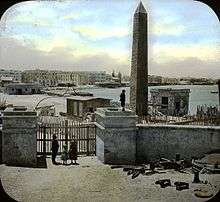
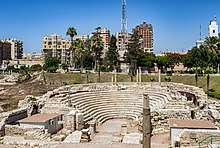

Due to the constant presence of war in Alexandria in ancient times, very little of the ancient city has survived into the present day. Much of the royal and civic quarters sank beneath the harbour and the rest has been built over in modern times.
"Pompey's Pillar", a Roman triumphal column, is one of the best-known ancient monuments still standing in Alexandria today. It is located on Alexandria's ancient acropolis—a modest hill located adjacent to the city's Arab cemetery—and was originally part of a temple colonnade. Including its pedestal, it is 30 m (99 ft) high; the shaft is of polished red granite, 2.7 m (8.9 ft) in diameter at the base, tapering to 2.4 m (7.9 ft) at the top. The shaft is 88 feet (27 m) high, and made out of a single piece of granite. Its volume is 132 cubic meters (4,662 cubic feet) and weight approximately 396 tons.[41] Pompey's Pillar may have been erected using the same methods that were used to erect the ancient obelisks. The Romans had cranes but they were not strong enough to lift something this heavy. Roger Hopkins and Mark Lehrner conducted several obelisk erecting experiments including a successful attempt to erect a 25-ton obelisk in 1999. This followed two experiments to erect smaller obelisks and two failed attempts to erect a 25-ton obelisk.[42][43] The structure was plundered and demolished in the 4th century when a bishop decreed that Paganism must be eradicated. "Pompey's Pillar" is a misnomer, as it has nothing to do with Pompey, having been erected in 293 for Diocletian, possibly in memory of the rebellion of Domitius Domitianus. Beneath the acropolis itself are the subterranean remains of the Serapeum, where the mysteries of the god Serapis were enacted, and whose carved wall niches are believed to have provided overflow storage space for the ancient Library. In more recent years, many ancient artifacts have been discovered from the surrounding sea, mostly pieces of old pottery.
Alexandria's catacombs, known as Kom El Shoqafa, are a short distance southwest of the pillar, consist of a multi-level labyrinth, reached via a large spiral staircase, and featuring dozens of chambers adorned with sculpted pillars, statues, and other syncretic Romano-Egyptian religious symbols, burial niches, and sarcophagi, as well as a large Roman-style banquet room, where memorial meals were conducted by relatives of the deceased. The catacombs were long forgotten by the citizens until they were discovered by accident in 1900.[44]
The most extensive ancient excavation currently being conducted in Alexandria is known as Kom El Deka. It has revealed the ancient city's well-preserved theater, and the remains of its Roman-era baths.
Persistent efforts have been made to explore the antiquities of Alexandria. Encouragement and help have been given by the local Archaeological Society, and by many individuals, notably Greeks proud of a city which is one of the glories of their national history. Excavations were performed in the city by Greeks seeking the tomb of Alexander the Great without success. The past and present directors of the museum have been enabled from time to time to carry out systematic excavations whenever opportunity is offered; D. G. Hogarth made tentative researches on behalf of the Egypt Exploration Fund and the Society for the Promotion of Hellenic Studies in 1895; and a German expedition worked for two years (1898–1899). But two difficulties face the would-be excavator in Alexandria: lack of space for excavation and the underwater location of some areas of interest.
Since the great and growing modern city stands immediately over the ancient one, it is almost impossible to find any considerable space in which to dig, except at enormous cost. Cleopatra VII's royal quarters were inundated by earthquakes and tsunami, leading to gradual subsidence in the 4th century AD.[45] This underwater section, containing many of the most interesting sections of the Hellenistic city, including the palace quarter, was explored in 1992 and is still being extensively investigated by the French underwater archaeologist Franck Goddio and his team.[46] It raised a noted head of Caesarion. These are being opened up to tourists, to some controversy.[47] The spaces that are most open are the low grounds to northeast and southwest, where it is practically impossible to get below the Roman strata.
The most important results were those achieved by Dr. G. Botti, late director of the museum, in the neighborhood of "Pompey's Pillar", where there is a good deal of open ground. Here, substructures of a large building or group of buildings have been exposed, which are perhaps part of the Serapeum. Nearby, immense catacombs and columbaria have been opened which may have been appendages of the temple. These contain one very remarkable vault with curious painted reliefs, now artificially lit and open to visitors.
The objects found in these researches are in the museum, the most notable being a great basalt bull, probably once an object of cult in the Serapeum. Other catacombs and tombs have been opened in Kom El Shoqafa (Roman) and Ras El Tin (painted).
The German excavation team found remains of a Ptolemaic colonnade and streets in the north-east of the city, but little else. Hogarth explored part of an immense brick structure under the mound of Kom El Deka, which may have been part of the Paneum, the Mausolea, or a Roman fortress.
The making of the new foreshore led to the dredging up of remains of the Patriarchal Church; and the foundations of modern buildings are seldom laid without some objects of antiquity being discovered. The wealth underground is doubtlessly immense; but despite all efforts, there is not much for antiquarians to see in Alexandria outside the museum and the neighborhood of "Pompey's Pillar".
Temple of Taposiris Magna
The temple was built in the Ptolemy era and dedicated to Osiris, which finished the construction of Alexandria. It is located in Abusir, the western suburb of Alexandria in Borg el Arab city. Only the outer wall and the pylons remain from the temple. There is evidence to prove that sacred animals were worshiped there. Archaeologists found an animal necropolis near the temple. Remains of a Christian church show that the temple was used as a church in later centuries. Also found in the same area are remains of public baths built by the emperor Justinian, a seawall, quays and a bridge. Near the beach side of the area, there are the remains of a tower built by Ptolemy II Philadelphus. The tower was an exact scale replica of the destroyed Alexandrine Pharos Lighthouse.[48]
Places of worship
Among the places of worship, there are Muslim mosques.[49] Coptic Christian churches are most common churches .There are also other Christian churches as: Greek , Latin and Armenian . Orthodox Christian churches are most common but Catholic , Anglican and Evangelical churches are present. Also there is a Jewish synagogue
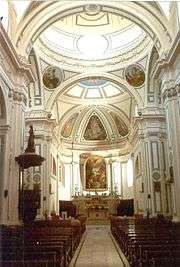
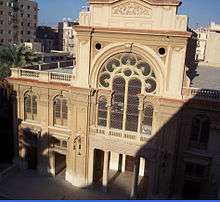
Islam
The most famous mosque in Alexandria is Abu al-Abbas al-Mursi Mosque in Bahary. Other notable mosques in the city include Ali ibn Abi Talib mosque in Somouha, Bilal mosque, al-Gamaa al-Bahari in Mandara, Hatem mosque in Somouha, Hoda el-Islam mosque in Sidi Bishr, al-Mowasah mosque in Hadara, Sharq al-Madina mosque in Miami, al-Shohadaa mosque in Mostafa Kamel, Al Qa'ed Ibrahim Mosque, Yehia mosque in Zizinia, Sidi Gaber mosque in Sidi Gaber, Sidi B esher mosque, Rokay el-Islam mosque in Elessway, Elsadaka Mosque in Sidibesher Qebly, Elshatbi mosque and Sultan mosque.
Alexandria is the base of the Salafi movements in Egypt. Al-Nour Party, which is based in the city and overwhelmingly won most of the Salafi votes in the 2011–12 parliamentary election, supports the president Abdel Fattah el-Sisi.[11]
Christianity
After Rome and Constantinople, Alexandria was considered the third-most important seat of Christianity in the world. The Pope of Alexandria was second only to the bishop of Rome, the capital of the Roman Empire until 430. The Church of Alexandria had jurisdiction over most of the continent of Africa. After the Council of Chalcedon in AD 451, the Church of Alexandria was split between the Miaphysites and the Melkites. The Miaphysites went on to constitute what is known today as the Coptic Orthodox Church of Alexandria. The Melkites went on to constitute what is known today as the Greek Orthodox Church of Alexandria. In the 19th century, Catholic and Protestant missionaries converted some of the adherents of the Orthodox churches to their respective faiths.
Today, the Patriarchal seat of the Pope of the Coptic Orthodox Church is Saint Mark Cathedral . The most important Coptic Orthodox churches in Alexandria include Pope Cyril I Church in Cleopatra, Saint Georges Church in Sporting, Saint Mark & Pope Peter I Church in Sidi Bishr, Saint Mary Church in Assafra, Saint Mary Church in Gianaclis, Saint Mina Church in Fleming, Saint Mina Church in Mandara and Saint Takla Haymanot's Church in Ibrahimeya.
The most important Eastern Orthodox churches in Alexandria are Agioi Anárgyroi Church, Church of the Annunciation, Saint Anthony Church, Archangels Gabriel & Michael Church, Taxiarchon Church, Saint Catherine Church, Cathedral of the Dormition in Mansheya, Church of the Dormition, Prophet Elijah Church, Saint George Church, Saint Joseph Church in Fleming, Saint Joseph of Arimathea Church, Saint Mark & Saint Nektarios Chapel in Ramleh, Saint Nicholas Church, Saint Paraskevi Church, Saint Sava Cathedral in Ramleh, Saint Theodore Chapel and the Russian church of Saint Alexander Nevsky in Alexandria, which serves the Russian speaking community in the city.
The Apostolic Vicariate of Alexandria in Egypt-Heliopolis-Port Said has jurisdiction over all Latin Church Catholics in Egypt. Member churches include Saint Catherine Church in Mansheya and Church of the Jesuits in Cleopatra. The city is also the nominal see of the Melkite Greek Catholic titular Patriarchate of Alexandria (generally vested in its leading Patriarch of Antioch) and the actual cathedral see of its Patriarchal territory of Egypt, Sudan and South Sudan, which uses the Byzantine Rite, and the nominal see of the Armenian Catholic Eparchy of Alexandria (for all Egypt and Sudan, whose actual cathedral is in Cairo), a suffragan of the Armenian Catholic Patriarch of Cilicia, using the Armenian Rite.
The Saint Mark Church in Shatby, founded as part of Collège Saint Marc, is multi-denominational and holds liturgies according to Latin Catholic, Coptic Catholic and Coptic Orthodox rites.
In antiquity, Alexandria was a major center of the cosmopolitan religious movement called Gnosticism (today mainly remembered as a Christian heresy).
Judaism
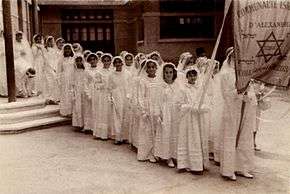
Alexandria's once-flourishing Jewish community declined rapidly following the 1948 Arab–Israeli War, after which negative reactions towards Zionism among Egyptians led to Jewish residents in the city, and elsewhere in Egypt, being perceived as Zionist collaborators. Most Jewish residents of Egypt fled to the newly established Israel, France, Brazil and other countries in the 1950s and 1960s. The community once numbered 50,000 but is now estimated at below 50.[50] The most important synagogue in Alexandria is the Eliyahu Hanavi Synagogue.
Education
Colleges and universities
Alexandria has a number of higher education institutions. Alexandria University is a public university that follows the Egyptian system of higher education. Many of its faculties are internationally renowned, most notably its Faculty of Medicine & Faculty of Engineering. In addition, the Egypt-Japan University of Science and Technology in New Borg El Arab city is a research university set up in collaboration between the Japanese and Egyptian governments in 2010. The Arab Academy for Science, Technology & Maritime Transport is a semi-private educational institution that offers courses for high school, undergraduate level, and postgraduate students. It is considered the most reputable university in Egypt after the AUC American University in Cairo because of its worldwide recognition from board of engineers at UK & ABET in US. Université Senghor is a private French university that focuses on the teaching of humanities, politics and international relations, which mainly recruits students from the African continent. Other institutions of higher education in Alexandria include Alexandria Institute of Technology (AIT) and Pharos University in Alexandria.
Schools
Alexandria has a long history of foreign educational institutions. The first foreign schools date to the early 19th century, when French missionaries began establishing French charitable schools to educate the Egyptians. Today, the most important French schools in Alexandria run by Catholic missionaries include Collège de la Mère de Dieu, Collège Notre Dame de Sion, Collège Saint Marc, Ecoles des Soeurs Franciscaines (four different schools), École Girard, École Saint Gabriel, École Saint-Vincent de Paul, École Saint Joseph, École Sainte Catherine, and Institution Sainte Jeanne-Antide. As a reaction to the establishment of French religious institutions, a secular (laic) mission established Lycée el-Horreya, which initially followed a French system of education, but is currently a public school run by the Egyptian government. The only school in Alexandria that completely follows the French educational system is Lycée Français d'Alexandrie (École Champollion). It is usually frequented by the children of French expatriates and diplomats in Alexandria. The Italian school is the Istituto "Don Bosco".
English schools in Alexandria are becoming the most popular. English-language schools in the city include: Riada American School, Riada Language School, Alexandria Language School, Future Language School, Future International Schools (Future IGCSE, Future American School and Future German school), Alexandria American School, British School of Alexandria, Egyptian American School, Pioneers Language School, Princesses Girls' School, Sidi Gaber Language School, Taymour English School, Sacred Heart Girls' School, Schutz American School, Victoria College, El Manar Language School for Girls (previously called Scottish School for Girls), Kawmeya Language School, El Nasr Boys' School (previously called British Boys' School), and El Nasr Girls' College. There are only two German schools in Alexandria which are Deutsche Schule der Borromärinnen (DSB of Saint Charles Borromé) and Neue Deutsche Schule Alexandria, which is run by Frau Sally Hammam.
The Montessori educational system was first introduced in Alexandria in 2009 at Alexandria Montessori.
The most notable public schools in Alexandria include El Abbassia High School and Gamal Abdel Nasser High School.
Women
Circa the 1890s, twice the percentage of women in Alexandria knew how to read compared to the same percentage in Cairo. As a result, specialist women's publications like al-Fatāh by Hind Nawal, the country's first women's' journal, appeared.[51]
Transport
Airports
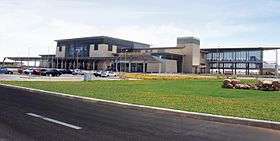
The city's principal airport is currently Borg El Arab Airport, which is located about 25 km (16 mi) away from the city center.
From late 2011, El Nouzha Airport (Alexandria International Airport) was to be closed to commercial operations for two years as it underwent expansion, with all airlines operating out of Borg El Arab Airport from then onwards, where a brand new terminal was completed there in February 2010.[52] In 2017, the government announced that Alexandria International Airport will shut down permanently for operational reasons.
Port
.jpg)
Alexandria has four ports; namely the Western Port also known as(Alexandria Port), which is the main port of the country that handles about 60% of the country's exports and imports, Dekhela Port west of the Western Port, the Eastern Port which is a yachting harbor, and Abu Qir Port at the northern east of the governorate. It is a commercial port for general cargo and phosphates.
Highways
- International Coastal Road (Mersa Matruh – Alexandria – Port Said)
- Cairo–Alexandria Desert Road (Alexandria – Cairo – 220 km (137 mi), 6–8 lanes)
- Cairo-Alexandria Agriculture Road (Alexandria – Cairo)
- Mehwar El Ta'meer – (Alexandria – Borg El Arab)
Rail
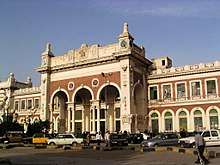
Alexandria's intracity commuter rail system extends from Misr Station (Alexandria's primary intercity railway station) to Abu Qir, parallel to the tram line. The commuter line's locomotives operate on diesel, as opposed to the overhead-electric tram.
Alexandria plays host to two intercity railway stations: the aforementioned Misr Station (in the older Manshia district in the western part of the city) and Sidi Gaber railway station (in the district of Sidi Gaber in the center of the eastern expansion in which most Alexandrines reside), both of which also serve the commuter rail line. Intercity passenger service is operated by Egyptian National Railways.
Trams
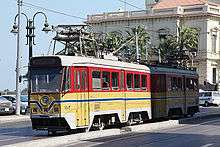
An extensive tramway network was built in 1860 and is the oldest in Africa. The network begins at the El Raml district in the west and ends in the Victoria district in the east. Most of the vehicles are blue in color. Some smaller yellow-colored vehicles have further routes beyond the two main endpoints. The tram routes have one of four numbers: 1, 2, 5, and 6. All four start at El Raml, but only two (1 and 2) reach Victoria. There are two converging and diverging points. The first starts at Bolkly (Isis) and ends at San Stefano. The other begins at Sporting and ends at Mostafa Kamel. Route 5 starts at San Stefano and takes the inner route to Bolkly. Route 6 starts at Sidi Gaber El Sheikh in the outer route between Sporting and Mustafa Kamel. Route 1 takes the inner route between San Stefano and Bolkly and the outer route between Sporting and Mustafa Kamel. Route 2 takes the route opposite to Route 1 in both these areas. The tram fares are 50 piastres (0.50 pounds), and 100 piastres (1.00 pounds) for the middle car. Some trams (that date back the 30s) charge a pound. The tram is considered the cheapest method of public transport. A café operates in the second floor of the first car of tram 1 (a women-only car) which costs 5 L.E per person, also offering a WiFi service. A luxury light blue tram car operates from San Stefano to Ras El Tin, with free WiFi and movies and songs played inside for 5 L.E per ticket.
Stations:
- Baccos – Victoria (Number 1)
- Al Seyouf
- Sidi Beshr
- El Saraya
- Laurent Louran
- Tharwat
- San Stefano
- Gianaklis
- Schutz
- Safar
- Abou Shabana (Baccos)
- Al Karnak (Fleming)
- Al Wezara (The Ministry)
- Isis Bolkly Bulkley
- Roushdy
- Mohammed Mahfouz
- Mustafa Kamil
- Sidi Gaber Al-Sheikh
- Cleopatra Hammamat (Cleopatra Baths)
- Cleopatra El Soghra
- El Reyada El Kobra (Sporting El Kobra)
- El Reyada El Soghra (Sporting Al Soghra)
- Al Ibrahimiyya
- El Moaskar (Camp Caesar)
- Al Gamaa (The University)
- Al Shatby
- El Shobban El Moslemin
- El Shahid Moustafa Ziean
- Hassan Rasim (Azarita)
- Gamea' Ibrahim (Mosque of Ibrahim)
- Mahattet Al Ramleh (Ramlh Station)
Route 2 serves:
- El Nasr – Victoria (Number 2)
- Al Seyouf
- Sidi Beshr
- El Saraya
- Louran
- Tharwat
- San Stefano
- Kasr El Safa (Zizini Al Safa Palace)
- Al Fonoun Al Gamella (The Fine Arts)
- Ramsis (Glym or Gleem)
- El Bostan (Saba Pasha)
- Al Hedaya (The Guidance)
- Isis Bolkly
- Roushdy
- Mohammed Mahfouz
- Mustafa Kamil
- Sidi Gaber El Mahata (Railway station)
- Cleopatra (Zananere)
- El Reyada El Kobra (Sporting El Kobra)
- El Reyada El Soghra (Sporting Al Soghra)
- Al Ibrahimiyya
- El Moaskar (Camp Chezar)
- Al Gamaa (The University)
- Al Shatby
- El Shobban El Moslemin
- El Shahid Moustafa Ziean
- Hassan Rasim (Azarita)
- Gamea' Ibrahim (Mosque of Ibrahim)
- Mahattet Al Ramlh (Ramlh Station)
Metro
Construction of the Alexandria Metro is due to begin in 2020 at a cost of $1.05 billion.[53]
Taxis and minibuses
Taxis in Alexandria sport a yellow-and-black livery and are widely available. While Egyptian law requires all cabs to carry meters, these generally do not work and fares must be negotiated with the driver on either departure or arrival.
The minibus share taxi system, or mashrū' operates along well-known traffic arteries. The routes can be identified by both their endpoints and the route between them:
- Corniche routes:
- El Mandara – Bahari
- El Mandara – El Mansheya
- Asafra – Bahari
- Asafra – El Mansheya
- El Sa'aa – El Mansheya
- Abu Qir routes:
- El Mandara – El Mahata (lit. "the Station", i.e. Misr Railway Station)
- Abu Qir – El Mahata
- Victoria – El Mahata
- El Mandara – Victoria
- Interior routes:
- Cabo – Bahari
- El Mansheya – El Awayid
- El Mansheya – El Maw'af El Gedid (the New Bus Station)
- Hadara – El Mahata
The route is generally written in Arabic on the side of the vehicle, although some drivers change their route without changing the paint. Some drivers also drive only a segment of a route rather than the whole path; such drivers generally stop at a point known as a major hub of the transportation system (for example, Victoria) to allow riders to transfer to another car or to another mode of transport.
Fare is generally L.E. 3.00 to travel the whole route. Shorter trips may have a lower fare, depending on the driver and the length of the trip.
Culture
Libraries
The Royal Library of Alexandria, in Alexandria, Egypt, was once the largest library in the world. It is generally thought to have been founded at the beginning of the 3rd century BC, during the reign of Ptolemy II of Egypt. It was likely created after his father had built what would become the first part of the library complex, the temple of the Muses—the Museion, Greek Μουσείον (from which the Modern English word museum is derived).
It has been reasonably established that the library, or parts of the collection, were destroyed by fire on a number of occasions (library fires were common and replacement of handwritten manuscripts was very difficult, expensive, and time-consuming). To this day the details of the destruction (or destructions) remain a lively source of controversy.[54]
The Bibliotheca Alexandrina was inaugurated in 2002, near the site of the old Library.[55]
Museums
- The Alexandria National Museum was inaugurated 31 December 2003. It is located in a restored Italian style palace in Tariq El Horreya Street (formerly Rue Fouad), near the center of the city. It contains about 1,800 artifacts that narrate the story of Alexandria and Egypt. Most of these pieces came from other Egyptian museums. The museum is housed in the old Al-Saad Bassili Pasha Palace, who was one of the wealthiest wood merchants in Alexandria. Construction on the site was first undertaken in 1926.
- Cavafy Museum
- The Graeco-Roman Museum
- The Museum of Fine Arts
- The Royal Jewelry Museum
Theaters
- Alexandria Opera House, where classical music, Arabic music, ballet, and opera are performed and bearm basha theatre in elshatby.
Architecture
Throughout Alexandria, there is art that resembles some of the oldest architectural styles of the Hellenic city, and its ancient decorations, especially in the Bibliotheca Alexandrina, is based on reviving the ancient Library of Alexandria. The Kom el shoqafa Catacombs are considered one of the Seven Wonders of the Middle Ages and date back to the 2nd century. The remnants of Pompey's Pillar still remain today. This single pillar represents the elaborate temple which once stood in Alexandria. It remains at the site of the Serapeum, Alexandria's acropolis. The Serapeum, which stood for ancient tradition, conflicted with the rise of Christianity. It is a large tourist destination, today. the Roman Amphitheatre of Alexandria is another popular destination. Here, there remains a stage with around seven hundred to eight hundred seats. They also have numerous galleries of statues and details leftover form this time. Alexandria's tourism office announced plans to reserve some beaches for tourists in July 2018.[56]
- Shalalat Gardens
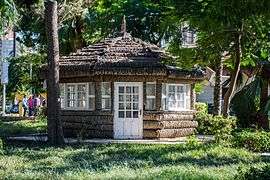
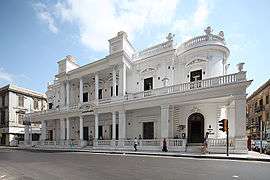 Alexandria Art Center
Alexandria Art Center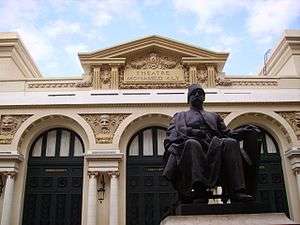
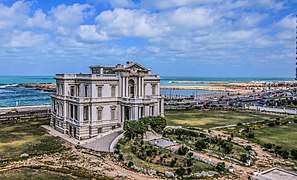 Fawzia Fahmy Palace
Fawzia Fahmy Palace.jpg) Alexander the Great's statue
Alexander the Great's statue.jpg) Monument of the Unknown Navy Soldier
Monument of the Unknown Navy Soldier
Sports
The main sport that interests Alexandrians is football, as is the case in the rest of Egypt and Africa. Alexandria Stadium is a multi-purpose stadium in Alexandria, Egypt. It is currently used mostly for football matches, and was used for the 2006 African Cup of Nations. The stadium is the oldest stadium in Egypt, being built in 1929. The stadium holds 20,000 people. Alexandria was one of three cities that participated in hosting the African Cup of Nations in January 2006, which Egypt won. Sea sports such as surfing, jet-skiing and water polo are practiced on a lower scale. The Skateboarding culture in Egypt started in this city. The city is also home to the Alexandria Sporting Club, which is especially known for its basketball team, which traditionally provides the country's national team with key players. The city hosted the AfroBasket, the continent's most prestigious basketball tournament, on four occasions (1970, 1975, 1983, 2003).
Alexandria has four stadiums:
- Alexandria Stadium
- Borg El Arab Stadium
- El Krom Stadium
- Harras El Hodoud Stadium
Other less popular sports like tennis and squash are usually played in private social and sports clubs, like:
- Acacia Country Club
- Alexandria Sporting Club – in "Sporting"
- Alexandria Country club
- Al Ittihad Alexandria Club
- Olympic Club
- Haras El Hodoud SC Club
- Koroum Club
- Lagoon Resort Courts
- Smouha SC – in "Smouha"
Started in 2011, Cross Egypt Challenge is an international cross-country motorcycle and scooter rally conducted throughout the most difficult tracks and roads of Egypt. Alexandria is known as the yearly starting point of Cross Egypt Challenge and a huge celebration is conducted the night before the rally starts after all the international participants arrive to the city.
International relations
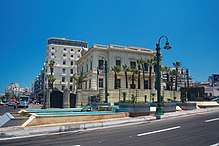
Alexandria is twinned with:




















See also
References
- "Alexandria Governor". Archived from the original on 12 February 2018.
- "الجهاز المركزي للتعبئة العامة والإحصاء". www.capmas.gov.eg. Archived from the original on 1 October 2018. Retrieved 27 October 2018.
- Erman, Adolf, and Hermann Grapow, eds. 1926–1953. Wörterbuch der aegyptischen Sprache im Auftrage der deutschen Akademien. 6 vols. Leipzig: J. C. Hinrichs'schen Buchhandlungen. (Reprinted Berlin: Akademie-Verlag GmbH, 1971).
- John Baines, "Possible implications of the Egyptian word for Alexandria", Journal of Roman Archaeology, Vol. 16 (2003), pp. 61–63. (Appendix to Judith McKenzie, "Glimpsing Alexandria from archaeological evidence".)
- "Alexandria". Collins Dictionary. n.d. Archived from the original on 11 June 2015. Retrieved 24 September 2014.
- "Travel in Egypt: Alexandria". Arab Academy. 10 August 2016. Retrieved 19 May 2020.
- Fideler, David (1 January 1993). Alexandria 2. Red Wheel/Weiser. ISBN 978-0-933999-97-8.
- Michael Haag (2004). Alexandria: City of Memory. Yale University Press. ISBN 978-0-300-10415-8.
- Fowden, Garth (26 February 2019). "Alexandria between Antiquity and Islam". Apollo-University of Cambridge Repository, Apollo-University of Cambridge Repository. doi:10.17863/CAM.37202. Cite journal requires
|journal=(help) - Justin Pollard; Howard Reid (30 October 2007). The Rise and Fall of Alexandria: Birthplace of the Modern World. Viking. p. 2-7. ISBN 978-0-14-311251-8.
- "The Lighthouse Dims". Foreign Policy. 23 December 2014. Archived from the original on 9 March 2017. Retrieved 5 March 2017.
- Véron, A.; Goiran, J. P.; Morhange, C.; Marriner, N.; Empereur, J. Y. (2006). "Pollutant lead reveals the pre-Hellenistic occupation and ancient growth of Alexandria, Egypt". Geophysical Research Letters. 33 (6). doi:10.1029/2006GL025824. ISSN 0094-8276.
- O'Connor, Lauren (2009) "The Remains of Alexander the Great: The God, The King, The Symbol," Constructing the Past: Vol. 10: Iss. 1, Article 8
- Erskine, Andrew (April 1995). "Greece & Rome, 2nd Ser". Culture and Power in Ptolemaic Egypt: The Museum and Library of Alexandria. 42 (1): 38–48 [42].
One effect of the newly created Hellenistic kingdoms was the imposition of Greek cities occupied by Greeks on an alien landscape. In Egypt, there was a native Egyptian population with its own culture, history, and traditions. The Greeks who came to Egypt, to the court or to live in Alexandria, were separated from their original cultures. Alexandria was the main Greek city of Egypt and within it there was an extraordinary mix of Greeks from many cities and backgrounds.
- Erskine, Andrew (April 1995). "Culture and Power in Ptolemaic Egypt: the Museum and Library of Alexandria". Greece & Rome. 42 (1): 38–48. doi:10.1017/S0017383500025213.
The Ptolemaic emphasis on Greek culture establishes the Greeks of Egypt with an identity for themselves. [...] But the emphasis on Greek culture does even more than this – these are Greeks ruling in a foreign land. The more Greeks can indulge in their own culture, the more they can exclude non-Greeks, in other words Egyptians, the subjects whose land has been taken over. The assertion of Greek culture serves to enforce Egyptian subjection. So the presence in Alexandria of two institutions devoted to the preservation and study of Greek culture acts as a powerful symbol of Egyptian exclusion and subjection. Texts from other cultures could be kept in the library, but only once they had been translated, that is to say Hellenized.
[...] A reading of Alexandrian poetry might easily give the impression that Egyptians did not exist at all; indeed Egypt itself is hardly mentioned except for the Nile and the Nile flood, [...] This omission of the Egypt and Egyptians from poetry masks a fundamental insecurity. It is no coincidence that one of the few poetic references to Egyptians presents them as muggers. - Delia, Diana (1988). "The Population of Roman Alexandria". Transactions of the American Philological Association. 118: 275–292. doi:10.2307/284172. JSTOR 284172.
- Philo of Alexandria, Against Flaccus.
- Ammianus Marcellinus, "Res Gestae", 26.10.15–19 Archived 17 March 2008 at the Wayback Machine
- Stiros, Stathis C.: "The AD 365 Crete earthquake and possible seismic clustering during the fourth to sixth centuries AD in the Eastern Mediterranean: a review of historical and archaeological data", Journal of Structural Geology, Vol. 23 (2001), pp. 545–562 (549 & 557)
- Kennedy, Hugh (1998). "Egypt as a Province in the Islamic Caliphate, 641–868". In Petry, Carl F. (ed.). Cambridge History of Egypt, Volume One: Islamic Egypt, 640–1517. Cambridge: Cambridge University Press. pp. 62–85 [69]. ISBN 0-521-47137-0.
- Bruning, Jelle (2018). The Rise of a Capital: Al-Fusṭāṭ and Its Hinterland, 18-132/639-750. Leiden and Boston: Brill. pp. 50–52. ISBN 978-90-04-36635-0.
- "Modern""The History of Alexandria". Archived from the original on 24 May 2013. Retrieved 24 May 2013.
- "Bombardment of Alexandria". Archived from the original on 13 November 2012. Retrieved 11 September 2017.
- Ted Thornton, "Nasser Assassination Attempt, 26 October 1954," Middle East History Database"Nasser Assassination Attempt, October 26, 1954". Archived from the original on 5 January 2010. Retrieved 24 May 2013.
- Ibn Batuta (2009). The travels of Ibn Battuta in the Near East, Asia and Africa 1304–1377. Translated by Lee, Samuel. New York: Cosimo. ISBN 9781605206219. OCLC 502998972.
- Clayton, Peter A.; Price, Martin (21 August 2013). "The Seven Wonders of the Ancient World". Routledge – via Google Books.
- Rostovtzeff 1941: (1138–39)
- Josiah Russell, 1958, "Late Ancient and Medieval Population," pp. 67 and 79.
- Elio Lo Cascio, 2009, "Urbanization as a Proxy of Growth," p. 97 citing Bagnall and Frier.
- "Koeppen-Geiger.vu-wien.ac.at". Archived from the original on 17 October 2011. Retrieved 30 November 2009.
- "Alexandria". Encyclopædia Britannica. Archived from the original on 29 May 2010. Retrieved 1 December 2009.
- "Egypt Climate Index". Climate Charts. Archived from the original on 23 June 2012. Retrieved 20 June 2013.
- "Deadly flash floods hit Egypt's Alexandria". aljazeera.com. Archived from the original on 12 October 2016. Retrieved 12 October 2016.
- "Clima en Alexandria / Nouzha – Históricos el tiempo". Tutiempo.net. Archived from the original on 15 June 2013. Retrieved 12 March 2013.
- "Alexandria, Egypt". Voodoo Skies. Archived from the original on 5 September 2015. Retrieved 3 August 2015.
- "Weather Information for Alexandria". Archived from the original on 10 February 2018. Retrieved 21 August 2017.
- "Climatological Information for Alexandria, Egypt" (1961–1990)". Hong Kong Observatory. Archived from the original on 1 February 2011. Retrieved 31 August 2010.
- "Alexandria, Egypt: Climate, Global Warming, and Daylight Charts and Data". Archived from the original on 1 January 2011. Retrieved 20 June 2013.
- Alexandria, Egypt Monthly Averages Archived 20 May 2013 at the Wayback Machine – Bing Weather[You must have an IP from the United States of America to see the page]
- "Alexandria Climate and Weather Averages, Egypt". Weather2Travel. Archived from the original on 5 January 2014. Retrieved 20 January 2014.
- The Pyramids and Sphinx by Desmond Stewart and editors of the Newsweek Book Division 1971 p. 80-81
- "NOVA Online | Mysteries of the Nile | 27 August 1999: The Third Attempt". Pbs.org. 27 August 1999. Archived from the original on 30 April 2009. Retrieved 5 May 2009.
- Time Life Lost Civilizations series: Ramses II: Magnificence on the Nile (1993)p. 56-57
- Planet, Lonely. "Catacombs of Kom ash-Suqqafa – Lonely Planet". lonelyplanet.com. Archived from the original on 6 February 2016. Retrieved 6 February 2016.
- "Fgs Project Alexandria". Underwaterdiscovery.org. Archived from the original on 7 March 2010. Retrieved 14 June 2010.
- "Divers probe underwater palace". BBC News. 28 October 1998. Archived from the original on 18 March 2007. Retrieved 19 January 2009.
- "New underwater tourist attraction in Egypt". BBC News. 24 September 2000. Archived from the original on 18 March 2007. Retrieved 19 January 2009.
- Judith McKenzie et al., The Architecture of Alexandria and Egypt, C. 300 B.C. to A.D. 700 New Haven CT: Yale University Press, 2007. 41-48. https://books.google.com/books?id=KFNCaZEZKYAC ISBN 9780300115550
- Britannica, Egypt Archived 8 July 2019 at the Wayback Machine, britannica.com, USA, accessed on 7 July 2019
- Egypt to restore Alexandria's historic synagogue, (20 December 2010) Archived 24 December 2010 at the Wayback Machine
- Kendall, Elisabeth. "Between Politics and Literature: Journals in Alexandria and Istanbul at the End of the Nineteenth Century" (Chapter 15). In: Fawaz, Leila Tarazi and C. A. Bayly (editors) and Robert Ilbert (collaboration). Modernity and Culture: From the Mediterranean to the Indian Ocean. Columbia University Press, 2002. ISBN 0231114273, 9780231114271. Start: p. 330. CITED: p. 340.
- "A new gateway for Alexandria". Al-Ahram Weekly. Archived from the original on 4 September 2009.
- "Egypt's $1bn Alexandria Metro to start construction in Q1 2020". Middle East Construction News. 10 November 2019. Retrieved 12 November 2019.
- Raven, James (2004). Lost Libraries: The Destruction of Great Book Collections Since Antiquity. Springer. p. 12. ISBN 0230524257.
- Long, Tony (16 October 2009). "Oct. 16, 2002: Second Great Library Opens in Alexandria" – via www.wired.com.
- "Egypt's Alexandria to create private tourist-only beaches". Egypt's Alexandria to create private tourist-only beaches (in Turkish). Archived from the original on 30 July 2018. Retrieved 30 July 2018.
- "Partner (Twin) towns of Bratislava". Bratislava-City.sk. Archived from the original on 28 July 2013. Retrieved 5 August 2013.
- "Sister Cities International (SCI)". Sister-cities.org. Archived from the original on 13 June 2015. Retrieved 21 April 2013.
- "Sister Cities Home Page". Archived from the original on 11 October 2012. eThekwini Online: The Official Site of the City of Durban
- "Accords de coopération Archived 4 March 2016 at the Wayback Machine" (PDF). Site Officiel de la Ville de Marseille (in French).
- "Limassol Twinned Cities". Limassol (Lemesos) Municipality. Archived from the original on 1 April 2013. Retrieved 29 July 2013.
- "Shanghai Foreign Affairs". www.shfao.gov.cn. Archived from the original on 18 May 2011. Retrieved 1 September 2018.
- "Международные и межрегиональные связи". gov.spb.ru (in Russian). Federal city of Saint Petersburg. Retrieved 30 January 2020.
- "Αδελφοποιημένες Πόλεις" Archived 24 April 2016 at the Wayback Machine. Municipality of Thessaloniki.
- "Paphos and Alexandria sign twining protocol". In-Cyprus.com. Archived from the original on 13 July 2018. Retrieved 13 July 2018.
- "Relazioni internazionali, siglato gemellaggio Catania-Alessandria d'Egitto". Archived from the original on 14 July 2019. Retrieved 14 July 2019.
Further reading
- A. Bernand, Alexandrie la Grande (1966)
- A. J. Butler, The Arab Conquest of Egypt (2nd. ed., 1978)
- P.-A. Claudel, Alexandrie. Histoire d'un mythe (2011)
- A. De Cosson, Mareotis (1935)
- J.-Y. Empereur, Alexandria Rediscovered (1998)
- E. M. Forster, Alexandria A History and a Guide (1922) (reprint ed. M. Allott, 2004)
- P. M. Fraser, Ptolemaic Alexandria (1972)
- M. Haag, Alexandria: City of Memory (2004) [20th-century social and literary history]
- M. Haag, Vintage Alexandria: Photographs of the City 1860–1960 (2008)
- M. Haag, Alexandria Illustrated
- R. Ilbert, I. Yannakakis, Alexandrie 1860–1960 (1992)
- R. Ilbert, Alexandrie entre deux mondes (1988)
- Judith McKenzie et al., The Architecture of Alexandria and Egypt, 300 B.C.–A.D. 700. (Pelican History of Art, Yale University Press, 2007)
- Philip Mansel, Levant: Splendour and Catastrophe on the Mediterranean, London, John Murray, 11 November 2010, hardback, 480 pages, ISBN 978-0-7195-6707-0, New Haven, Yale University Press, 24 May 2011, hardback, 470 pages, ISBN 978-0-300-17264-5
- Don Nardo, A Travel Guide to Ancient Alexandria, Lucent Books. (2003)
- V. W. Von Hagen, The Roads that Led to Rome (1967)
External links
| Wikimedia Commons has media related to: |
| Wikivoyage has a travel guide for Alexandria. |
- "Alexandria". Egyptian government, Ministry of state For Administrative Development. 2014.
- "Greek Community of Alexandria". 2015.
- Details on the archaïc port with a pdf of Gaston Jondet's report, 1916
- Map of Alexandria, ca.1930, Eran Laor Cartographic Collection, The National Library of Israel.
| Preceded by Sebennytos |
Capital of Egypt 331 BC – AD 641 |
Succeeded by Fustat |
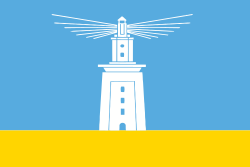
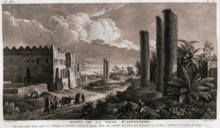
.jpg)
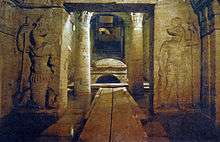
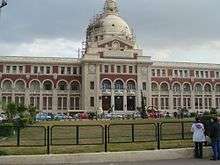

_-_Egypt-14A-048.jpg)
